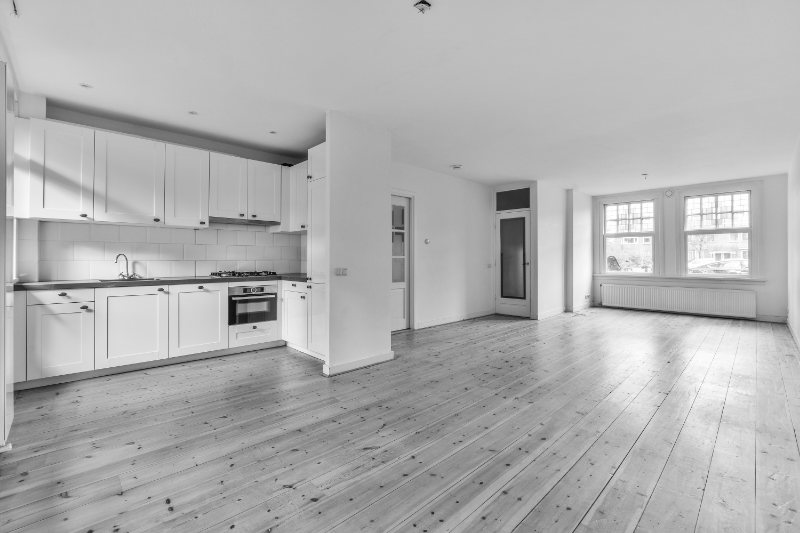A modern, open-floor plan house can be intimidating to new homeowners. These sprawling layouts lack defined boundaries, as most traditionally designed homes offer. Without clear divisions, creating separation for different activities in the space is often difficult. It’s also challenging to decorate well without sacrificing the sense of continuity.
This article provides advice on organizing open floor plans. You will learn to create smooth transitions between spaces and define distinct areas. Whether reorganizing for functionality or style, regardless of your open floor plan’s size, you will surely find these practices helpful.
Ready to flip your open floor plan into a balanced, orderly living space? Learn how you can make open floor plans work for you below.
Understanding the benefits and challenges of open floor plans
Before you begin working on an open floor plan, learn what makes that type of layout special, yet simultaneously problematic. Knowing these strengths and weaknesses upfront allows you to swiftly apply organizing tips for open floor plans that align with the layout.
Advantages of open floor plans
An open floor plan home features an almost wall-less interior design.
The walls separating common areas like the kitchen, living room, and dining room are minimized or even removed altogether. Here are some advantages you could get with an open-plan layout:
- Maximizes natural light. One of the best things about this is that it maximizes the natural light intensity in your home, making it brighter and more inviting. This even reduces the need for artificial lighting during the day.
- Improves ease of mobility. You can easily move from one area to another, as no doors and walls can get in your way. This is especially handy for families and those who love to entertain; it keeps everyone engaged and interacting with one another wherever they are in the home while cooking in the kitchen or lounging in the living room.
- Brings a sense of spaciousness. Even in smaller homes, the lack of walls makes everything appear bigger and more open. This extra sense of space can make a home more comfortable and even airy, with relaxed vibes ideal for everyday life.
Challenges in organizing open spaces
However, one of the biggest challenges in organizing and decorating open floor plans is the lack of definite areas.
Since no walls separate your spaces, it becomes hard to tell where one zone ends and another begins. For instance, when does your office floor plan become a living area? Because of this, it can sometimes feel a little chaotic, especially when trying to separate specific areas for certain activities.
Another concern you may consider is how you will deal with clutter. Since everything is out in the open, it can be easily viewed. It might give the impression that the entire space looks messy. With minimal doors to close rooms off or hide stuff in, keeping on top of tidying becomes more important — and sometimes, that can feel like a lot to manage.
You can also find it difficult to have a consistent design in an open floor plan. Since all your spaces are combined, the kind of style, color, and furniture you choose should all complement each other. Otherwise, you can end up with spaces that clash rather than complement one another.
This requires a bit more consideration to ensure that everything goes smoothly and your home remains unified and balanced.
Protocols for organizing open floor plans
Organizing open floor plans can help you create a beautiful and functional home. Using scientifically backed advice, you can organize spaces that promote your well-being and productivity. This means paying attention to factors like space optimization, lighting, and movement to organize a home that works best for you.
Start by learning these basic open floor plan organization protocols to enhance your knowledge.
Define zones with furniture arrangement
You can do this by using large and versatile furniture.
- Utilizing a sofa between two areas. A sofa with its back to the dining area naturally separates the living and dining spaces. This makes the two zones visually and functionally distinct without the need for a wall.
- Utilizing a bookcase. You can use a bookcase or tall, thin cabinet as a partition to create partial separation while adding storage. This maintains an open flow while distinguishing zones, which is especially useful for home offices with limited space.
- Utilizing larger pieces of furniture. A console table behind your sofa is an unobtrusive definition between spaces. Also, decorative screens or open-frame dividers can create separation without lessening the openness of this layout.
Read more: Enhancing Privacy at Home: Why is it Important?
Use rugs to anchor spaces
Rugs also work to define and anchor your spaces.
A rug under each key zone, such as the kitchen and family room in an open floor plan, provides a visual boundary that creates separation among these spaces without using walls. This will delineate each area, giving you that organized feel and sense of where an area ends and another begins.
Aside from their function as a visual divider, rugs are also beneficial additions to your design style.
Available in various colors, patterns, and textures, they will make each zone show its taste and personality.
For instance, a soft, patterned rug under a coffee table may add warmth to your living space. Under the dining table, something sleek and modern can lend a touch of sophistication.
Read more: Unlocking the Potential of Your Living Room With Functional Zones
Create visual boundaries with color and decor
Effective use of color and decor can help subtly separate the spaces of your open floor plan without any need to build additional walls.
- Separate with the color palette. To separate spaces in an open floor plan with color, start with a neutral base for a unified look. Then, add different shades to highlight specific areas like the kitchen or living room. Subtle color shifts or bold contrasts help separate spaces without closing them off.
- Utilize accent color. In an open space, painting one area as a focal point with bold colors and decorating it with eye-catching items can create visual interest while maintaining a connected feel. You can utilize areas like a fireplace, television, or game corner.
- Utilize decor items. To define spaces and ensure cohesion, use distinct styles for different areas. For example, use colorful bins and playful artwork in a children’s play area while opting for sleek shelves and sophisticated decor in the adult seating area. This approach separates zones and enhances the room’s overall design.
Read more: Form Meets Function: The Essential Guide to Balanced Home Decor
Incorporate multi-functional furniture
One of the most important things in making good use of space in your home is choosing multi-functional furniture pieces.
For example, if you have a guest room that doubles as a home office, then you would want to get something like a daybed that doubles as a sofa or even a desk that folds away. This way, you will easily switch from guest hosting mode to working-from-home mode, all while ensuring comfort and functionality.
Another great example is using an ottoman with hidden storage. It provides a sleek surface for setting drinks and snacks while letting you store extra blankets, books, and other items out of sight.
For another multi-functional furniture you could use at your open floor home, consider trying these furniture:
- Folding chairs can be easily stored away when not in use.
- Nesting tables can be stacked or separated to create various configurations.
- Murphy beds fold up against the wall to save space.
- Storage benches offer both seating and storage.
- Underbed storage containers maximize space by storing items under the bed.
- Bookshelves with drawers combine storage for books and other items.
With multi-purpose furniture, you will not only save valuable space but also integrate flexibility and efficiency into your living environment. Such pieces of furniture will help you adjust your home according to changing needs and activities, providing the maximum return on every square foot.
Maintain an organized flow
A clear flow from one zone to the next helps sustain a comfortable, practical, and calm living space within your open floor plan.
If each area flows smoothly into the next, the space will scarcely feel cluttered or chaotic. This can retain the serenity of the general environment while also making it comfortable to move around or enjoy the space.
To maintain this organized flow, keep the pathways open to create a free flow from one space into another. Avoid overcrowding your rooms with too much furniture or any other decor by decluttering regularly to sort your items.
Also, consider how zones connect on a visual and functional level.
Complementary colors, textures, and styles help connect all of the different areas in a cohesive look. If every space feels like a natural flow into the next one, you will end up with a harmonious, well-organized space, which will improve the overall living experience.
Read more: Stop Procrastinating, Start Decluttering
In conclusion
Some of the challenges with an open floor plan are marking out different areas and controlling clutter.
Following the protocols above will help in overcoming these issues and can make a space that is both beautiful and useful. These will help refashion an open floor plan into a structured, welcoming living space. Your open floor plan will become a harmonious and stylish abode.
Now, it is your turn. By using these protocols, you can transform your open floor plan into a much more organized, practical, and beautiful living space. With some creativity and thoughtful planning, you can make your open floor plan work for you by creating a harmonious and inviting home.
If you would like to see more resources on floor plans, check out the Home Organization Science Labs. The lab uses the research of the Institute for Life Management Science to produce courses, certifications, podcasts, videos, and other tools. Visit the Home Organization Science Labs today.
Photo by wirestock on Freepik


